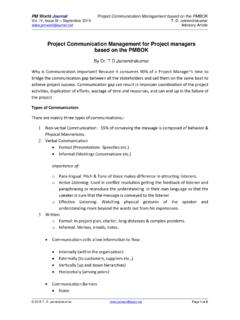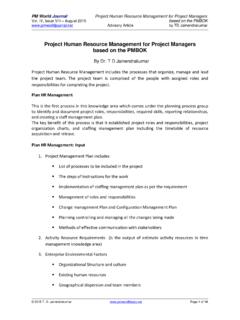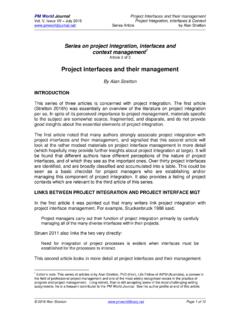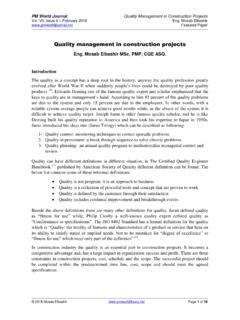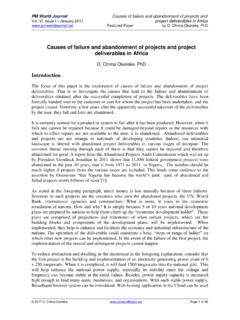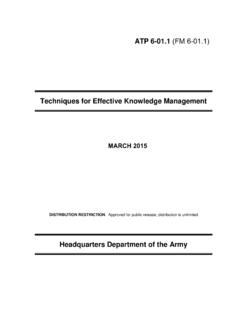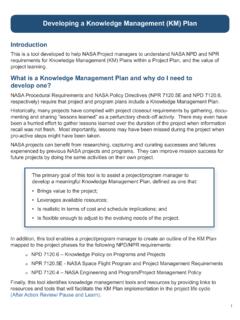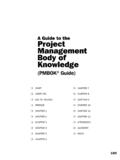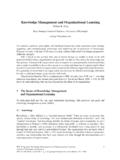Transcription of PMI’s Models of Project Management Knowledge – Life …
1 PM World Journal Life Cycles, Process Groups and Knowledge Areas Vol. VII, Issue I January 2018 by Crispin (Kik) Piney Featured Paper 2018 Crispin (Kik) Piney Page 1 of 16 PMI s Models of Project Management Knowledge Life Cycles, Process Groups and Knowledge Areas Crispin (Kik) Piney , PgMP 1. Foreword I started to think about these points in 2010, when all of the PMI standards used a process-based approach. Over the years, I exchanged a few emails with Max Wideman who provided useful comments and encouraged me to complete the analysis. On reading the Sixth Edition of the PMBOK Guide, I have found that my ideas are still valid. So, I have done my best to follow his advice. 2. Abstract The Standard for Project Management and the Guide to the Project Management Body of Knowledge (PMBOK Guide) [PMI, 2017] present Knowledge using three overlapping Models , as follows: life cycles, processes clustered into process groups, and Knowledge areas.
2 Analysis of these Models shows that, although life cycles are a stand-alone concept, the other two Models should be presented in a hierarchical manner, with Knowledge areas as the highest level, subdivided with respect to the generic set of process groups, and these process groups containing the processes specific to the corresponding Knowledge area. It should be noted that this structure is not how the concepts were first developed for the early editions of the PMBOK Guide; however, the original structure was well-meant but incorrect. This note proposes a reworking of those initial ideas, to provide a consistent model that avoids the current and damaging confusion between process groups and life cycle phases. 3. Introduction PMI uses a three-dimensional model for structuring the Knowledge required in order to apply best practice in Project Management .
3 This model comprises processes, process groups (PGs), and Knowledge areas (KAs). This three-dimensional view can be confusing even to practitioners in the field. Experience shows that this is definitely the case for life cycles and process groups (this is even the case with books and training courses aimed specifically at PMI s PMP certification). The Devil s Dictionary of Project Management Terms [PM World Journal, 2017] provides a concise view of this confusion, as follows: Process Groups - Formal assemblages of processes based on characteristics of use to the assemblers rather than to the users of the concept. Its greatest benefit is as a basis for identifying people who do not understand Project Management , as they think that the process groups equate to Project life cycle phases . Many organizations attempt to base themselves on PMI s PMBOK Guide and do it wrongly.
4 Much of the responsibility for this confusion lies with the way in which the PMBOK Guide addresses the concept of PGs. For example, Figure 2-1 in The Standard for Project Management increases this confusion around the role of PGs (see Figure 1). In this diagram, the PGs (Initiating, Planning, Executing, Closing as well as Monitoring and Controlling) are presented as a cohesive sequence spanning the entire Project space; that, of course, is exactly the role of a life cycle. PM World Journal Life Cycles, Process Groups and Knowledge Areas Vol. VII, Issue I January 2018 by Crispin (Kik) Piney Featured Paper 2018 Crispin (Kik) Piney Page 2 of 16 Figure 1: Despite its Appearance, This is Not a Life Cycle Many books and courses describing PMI's standards also talk about PGs as if they were life cycle phases.
5 The authors of the PMBOK Guide recognize this, and, in a number of places, state explicitly that "process groups are not phases . However, by defining PGs in this way by what they are not may be an entertaining surrealist approach to the world (see Ceci n est pas une pomme by Ren Magritte in Figure 2) but cannot be relied upon to reduce confusion in a technical area. Figure 2: Ren Magritte's painting "This is Not an Apple" However, phases and PGs are valuable concepts if used correctly, and this confusion is damaging to the profession. PM World Journal Life Cycles, Process Groups and Knowledge Areas Vol. VII, Issue I January 2018 by Crispin (Kik) Piney Featured Paper 2018 Crispin (Kik) Piney Page 3 of 16 This article is designed to clear away the confusion and provide a basis for better understanding by proposing changes to the way the PMBOK Guide and The Standard for Project Management address these concepts.
6 The first step in determining how to achieve this is to understand the current approach used in the PMBOK Guide. 4. The Three Models PMI presents three ways of structuring the field of Project Management . These are: 1. Life cycles (section of the PMBOK Guide) 2. Processes arranged in five process groups (section ) 3. Knowledge areas (sections 4-13). Life Cycles A Project life cycle is a set of sequential, interdependent phases leading from the start to the end of the Project . It may be helpful to think of the life cycle of a butterfly (egg, caterpillar, pupa, butterfly)1. The role of a Project life cycle is to subdivide the chronological development of the Project into distinct parts (called phases ) in order to ensure effective Management and technical control by limiting the amount of future investment and work authorized at any point in time. In some circumstances, phases are subdivided into smaller elements, often called stages, as shown in Figure 3 below.
7 The phases are: Pre-design, Design, Pre-construction, Construction; construction has many (product-related) stages that are not shown. A diagram of this type also helps in identifying missing phases or stages. It is clear from Figure 3 that the Handover phase has been overlooked! Figure 3: Phases and Main Stages of a Building Project , with Go/Nogo Reviews at the End of Each Phase 1 As a terminological aside: life cycle refers to this development chain, lifetime refers to the period of time between the start and end of an item (we won t reach the stars in my lifetime) and lifespan measures the elapsed time from the start to the end of an event ( the average human lifespan is still increasing in many countries). PM World Journal Life Cycles, Process Groups and Knowledge Areas Vol. VII, Issue I January 2018 by Crispin (Kik) Piney Featured Paper 2018 Crispin (Kik) Piney Page 4 of 16 It is interesting to note that the PRINCE2 standard by OGC [OGC 2009] explicitly states that one defining characteristic of a Project is that it has a life cycle: in other words, if it does not have a life cycle, it is not a Project .
8 Processes A process in its most general form is a mechanism for transforming an input or set of inputs into an output or set of outputs by the application of a set of tools and techniques ( the drill a hole process starts with a piece of wood [the Input], uses a drill [the Tool] and delivers: a piece of wood with a hole, plus sawdust [the Outputs]). The whole subset of the Project Management body of Knowledge addressed by PMI is translated into a number of processes (49 in all). A process can only belong to a single PG and a single KA. Process Groups In the PMI standards, the processes are grouped into five PGs under the mnemonic IPECC: 1. Initiating 2. Planning 3. Executing 4. Controlling 5. Closing The potential for confusion arises because (apart from controlling ), the names of the groups could also apply to life cycle phases. The confusion is compounded by the fact that PMI presents the concept of processes and PGs before describing KAs.
9 This issue is explained in more detail later on in this article. Note however, that processes from the various PGs can be invoked in many phases. and IPECC repeats within each one of the phases. To be more precise, there are multiple, simultaneous, asynchronous IPECC cycles running within each phase ( , you may be identifying new risks, while executing a part of communication plan, while closing a procurement, etc.) Knowledge Areas A Knowledge area is a subdivision of the body of Knowledge that corresponds to a specific set of technical or managerial activities that require a specific set of skills and experience. There are ten Knowledge areas defined in the PMBOK Guide such as Time Management , Risk Management , etc. The relationship between KAs and PGs is key to understanding the true role of PGs. Knowledge Areas and Process Groups It is at this point that the full value of processes can be seen: for example, in order to be able to manage time effectively in a Project , you need to describe the actions clearly, and the process approach has obvious benefits for this.
10 The PGs provide a means of carrying out the analysis and definition of each Knowledge area in a consistent manner2. The PMBOK Guide describes the PGs in terms of their action within the life cycle as a whole. However, I will show that the 2 Apparently, in the original development of the PMBOK Guide, the initial decomposition of the body of Knowledge was in terms of processes. The concepts of process groups and of Knowledge areas were developed in order to cluster together processes with similar characteristics. PM World Journal Life Cycles, Process Groups and Knowledge Areas Vol. VII, Issue I January 2018 by Crispin (Kik) Piney Featured Paper 2018 Crispin (Kik) Piney Page 5 of 16 concept of PGs is much more powerful if it is applied within each KA separately.

